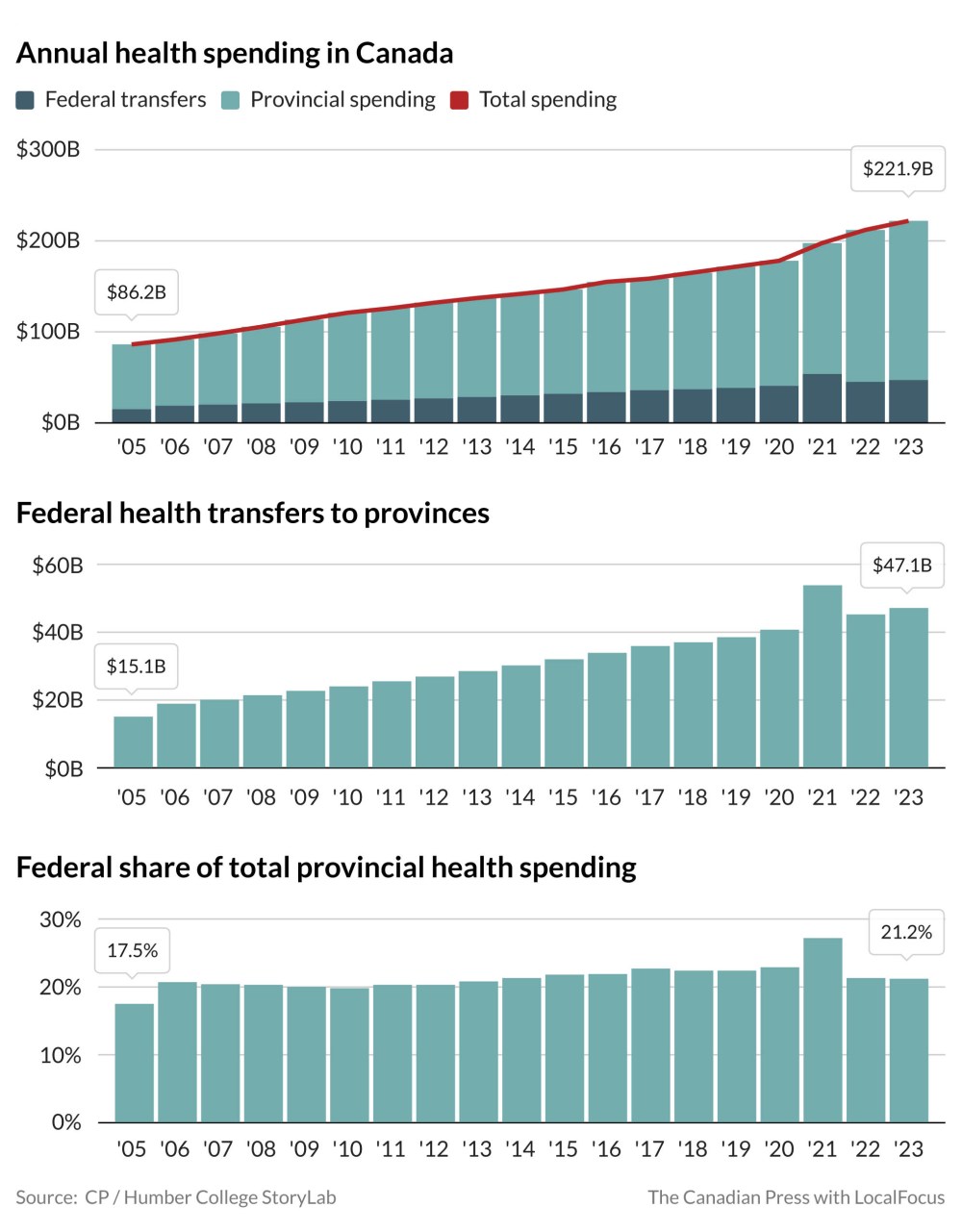The ups and downs (but mostly ups) of federal health transfers
Advertisement
Read this article for free:
or
Already have an account? Log in here »
To continue reading, please subscribe:
Monthly Digital Subscription
$0 for the first 4 weeks*
- Enjoy unlimited reading on winnipegfreepress.com
- Read the E-Edition, our digital replica newspaper
- Access News Break, our award-winning app
- Play interactive puzzles
*No charge for 4 weeks then price increases to the regular rate of $19.00 plus GST every four weeks. Offer available to new and qualified returning subscribers only. Cancel any time.
Monthly Digital Subscription
$4.75/week*
- Enjoy unlimited reading on winnipegfreepress.com
- Read the E-Edition, our digital replica newspaper
- Access News Break, our award-winning app
- Play interactive puzzles
*Billed as $19 plus GST every four weeks. Cancel any time.
To continue reading, please subscribe:
Add Free Press access to your Brandon Sun subscription for only an additional
$1 for the first 4 weeks*
*Your next subscription payment will increase by $1.00 and you will be charged $16.99 plus GST for four weeks. After four weeks, your payment will increase to $23.99 plus GST every four weeks.
Read unlimited articles for free today:
or
Already have an account? Log in here »
Hey there, time traveller!
This article was published 02/09/2024 (446 days ago), so information in it may no longer be current.
OTTAWA – The message Canada’s premiers sent to Ottawa last year was unanimous: the federal government needed to pay its fair share to contain the ballooning cost of health care.
Before Prime Minister Justin Trudeau put a 10-year, $196-billion deal on the table, they insisted federal contributions to health spending had slowly slackened over time.
Checking that claim proved more difficult than anticipated, since provincial spending and federal transfers are rarely centrally compiled and compared.

Canada's premiers hold a closing press conference at the Fairmont Empress in Victoria, B.C., on Tuesday, July 12, 2022. THE CANADIAN PRESS/Chad Hipolito
The Canadian Press, in partnership with Humber College StoryLab, collected data on provincial health budgets and federal health transfers from 2004 to 2023. The goal was to track annual spending from the launch of the 2004 federal-provincial health accord under former Liberal prime minister Paul Martin.
That was also the year a dedicated federal health care transfer was established.
Provincial health systems had taken a substantial hit in the late 1990s when Martin, then the finance minister, slashed federal transfers as Ottawa desperately tried to reign in its deficit.
Federal health transfers to the provinces, which totalled $18.5 billion in 1995-96, fell to $14.7 billion in 1997-98 and $12.5 billion in 1998-99. The figures have not been adjusted for inflation.
Five years later Martin, by then the prime minister, stepped in to try and fix what his austerity budgets had caused, signing a new, 10-year deal with the provinces to add more than $40 billion to federal health transfers over the decade.
The 2004 deal included some immediate injections of money as well as a pledge that federal health transfers would increase by at least six per cent a year.
Health transfers did rise substantially right out of the gate, from $15.1 billion in 2004-05 to $18.9 billion in 2005-06, before following the promised pattern and rising by at least six per cent each year through 2010-11.
In 2011, Conservative finance minister Jim Flaherty told premiers he would keep the six per cent escalator until 2016-17, after which health transfers would be tied to economic growth, but no less than three per cent each year.
The Liberals had returned to office under Justin Trudeau by the time that adjustment was set to kick in, but they kept the plan. Between 2017-18 and 2022-23 the Canada Health Transfer rose between three and five per cent annually.

Between 2005 and 2023, the federal transfers have risen seven per cent on average, compared to a five per cent increase in provincial health spending over that period.
In January 2023, after months of pleading from provinces, Trudeau put a new offer on the table, which included a guaranteed minimum increase of five per cent to the health transfer for five years. That was in addition to tailored one-on-one deals with each province.
The government anticipated at the time the offer would result in a 33 per cent increase in federal health spending over the next five years, and 61 per cent over 10 years.
In exchange, all provinces and territories agreed to sign on to a plan to gather and share data about Canada’s health systems.
So far, that does not include data about how much each level of government contributes to those systems.
This report by The Canadian Press was first published Sept. 2, 2024.
History
Updated on Tuesday, September 3, 2024 11:32 AM CDT: Adds graphic



